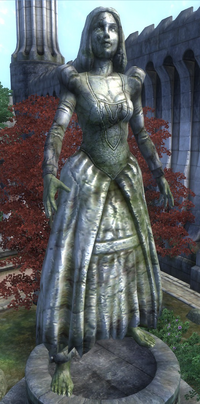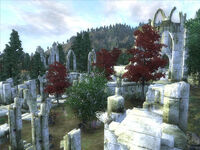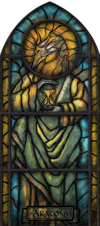
A statue of Saint Alessia in the Imperial City as it appears in The Elder Scrolls IV: Oblivion.
- Not to be confused with Alessia Caro, Alessia Ottus, or Alyssa.
Alessia (1E ??? - 1E 266), also known as the "Slave-Queen" or Al-Esh,[1] and later canonized as "Saint Alessia", was a Nedic woman during the First Era. Responsible for ending human enslavement by the Ayleids, she founded the first Cyrodilic Empire, became the first Empress of Cyrodiil and initiated worship of the Eight Divines. Upon her death, she became the first human saint. She is associated to the "winged-bull" Morihaus, which is said to be her demigod lover.
Names
She was originally called Al-Esh[1] (Aldmeri: "the high high"), name that was later translated to Aleshut, Esha and, most notably, Alessia. The name Paravant ("first of its kind", by which the gods meant a mortal worthy of the majesty that is "killing-questing-healing") was given to Alessia at her coronation.
From Paravant, arose Paraval, Pevesh, Perrethu and Paravania (which is what she was called by Morihaus when the two were lovers). The titles of First Empress, Lady of Heaven and Queen-ut-Cyrod are also cited by Morihaus.
Biography
Little is known of Alessia's early life. As a human slave in Cyrodiil, the heart of the Imperatum Saliache, where men knew no freedom, any record of her original tribe, family or given names were erased. But it is a fact that she grew up in Sardarvar Leed, known at the time as Sard, where the Ayleids herded in men from across all the Niben.[2]
Founding of Skyrim
In 1E 113, the Nordic King Harald had conquered Skyrim and founded the first human kingdom on the continent of Tamriel. Harald managed to drive the elves completely out of Skyrim, primarily into Cyrodiil and Morrowind, and the human slaves saw the possibility of doing the same to their own rulers. At the same time, the Ayleid government was severely fractured: dozens of separate kingdoms or city-states constantly fought against each other for power, and a strong minority of Ayleid nobility had become sympathetic to the human cause. Alessia appears to have taken advantage of the period of Ayleid civil war to launch her uprising.
Divine help for the Slave-Queen
At this point in Tamrielic history, Daedra and Aedra were still walking the surface of Nirn freely. The divines would often interfere directly with mortal affairs, as can be seen in the Daedric corruption of the Altmer to create the races of Chimer and Orsimer. The Ayleid generally worshiped the Altmeri divines, but also dealt frequently with Daedric Princes for assistance in keeping their slaves in line. The Nords of Skyrim worshipped a distinct group of divines, who were much more sympathetic to humanity than merfolk. Alessia began to pray to these divines for assistance in freeing her people, in particular Kynareth, whom the Nords called Kyne.
Kynareth sent her son, the Nordic demi-god hero Morihaus, to advise and aid Alessia. During this period, Morihaus is usually identified as Alessia's lover, though the Song of Pelinal claims he was embarrassed at his appearance because of her. He helped her to rally the other slaves to her cause. From that moment she was known as the Slave-queen.[3] Kynareth also sent Alessia visions that would aid her fight against her masters. The third of these visions was of another legendary figure of the First Era, the infamous shezarrine Pelinal Whitestrake, who was sent to Alessia to become the leader of her army.
Rebellion

Miscarcand, a city of the Ayleids, after many years of lying in ruins.
Around the year 1E 242, Alessia's rebel army finally struck out at their masters. Pelinal Whitestrake in particular became legendary for his brutal decimation of the Ayleid army. Alessia herself often had to intercede with the divines on his behalf after "the Madness" took him and he committed particularly atrocious acts. The Nordic king to the North wasted little time in joining Alessia's revolt, and the human armies quickly began to drive the Ayleid out of the populated regions of Cyrodiil. The human strategy was to drive the Ayleid inward, towards the White-Gold Tower, forcing the front into increasingly smaller circles around Lake Rumare.
It was during this period, late in the war, that the Ayleid king Umaril was given control of the Ayleid armies. Umaril, like Pelinal and Morihaus, was of a divine bloodline, having an Ayleid mother and a divine father. As such, he was one of the few able to match Pelinal in battle. To further his advantage, Umaril made a deal with the Daedric Lord Meridia, and was granted use of his Aurorans as foot soldiers. Pelinal eventually defeated Umaril, but just barely, and Umaril's spirit escaped to Oblivion where he would wait and return centuries later. The remaining Ayleid kings swarmed down on Pelinal's injured body, tore him into eight pieces, and left his head for Alessia and Morihaus to find.
However, even the death of Pelinal couldn't halt the human revolt. After years of fighting, Alessia's army finally took control of the White Gold Tower itself, ending forever the reign of the Ayleid in Tamriel. Alessia was named the first Empress of the Empire of Cyrodiil.
First Empire
Alessia's victory over the Ayleids was not possible without intervention from Skyrim, but she had at least as much help from rebel Ayleid lords during the siege of White Gold Tower. The popular image of the Ayleids as brutal slavemasters is a fact, but it is less well known that a number of Ayleid princes continued to rule parts of Cyrodiil after, as vassals of the new Empress of Cyrodiil. Alessia and her successors were more pragmatic than is traditionally believed.
Eight Divines
Alessia's first major act as Empress was to abolish worship of the Ayleid gods. However, she was a shrewd politician, enough to realize that her people had never known any other gods. The Nords violently opposed the Ayleid gods, and chiefly worshipped their version of Lorkhan, whom they called Shor. The elves, however, hated Lorkhan, whom they called "The Trickster", and completely rejected any worship of him. Alessia knew she had to be careful in choosing the official state religion; she could not afford to anger her Nordic allies, but her own people could not adjust to the complete Nordic pantheon in just a single generation. Her compromise was to merge the two religions, choosing to keep the less controversial Ayleid gods, such as Akatosh and bring in popular Nordic ones, such as Dibella and Kynareth. She sidestepped the issue of Lorkhan by leaving him out of her Eight Divines, but identifying him as the "missing ninth god", a brother to the Eight Divines who was otherwise absent from the pantheon. The worship of the Eight Divines, along with the Empire itself, would go on to become the most prominent religion across all of Tamriel.
The Death of Alessia

The Amulet of Kings.
Near the end of her reign, as Alessia lay dying, she was visited by Lorkhan, called Shezarr in Cyrodiil.[4] He brought with him a pact from Akatosh, the chief of all gods, for Alessia. Akatosh infused Alessia with his own divine blood, then had Shezarr place her soul into the newly formed Amulet of Kings. Akatosh then sealed off the planes of Oblivion, which kept the Aedra and Daedra from ever walking Nirn again. Alessia's soul was bound to this seal, as Akatosh vowed: as long as an heir of his and Alessia's joined blood sat on the throne of Cyrodiil, and wore the Amulet of Kings, the seal will remain in place and Tamriel would be safe from Oblivion. Thus from here the bloodline were called by the Nords of Skyrim as Dragonborn. Martin Septim was the last Dragonborn emperor to wear the Amulet of Kings and thereby sealed Oblivion forever.
As a sign of this vow, Akatosh lit the Dragonfires in the center of White Gold Tower. Akatosh is identified with the Dragon, a symbol which plays a prominent role in the Cyrodiilic Empire. A few centuries later, King Reman I, the hero who defeated the Akaviri Invasion, would formalize the process of lighting the Dragonfires and passing the Amulet as the rites used to crown a new Emperor; even during the worst periods of Cyrodiil's history, the fires remained lit and kept Tamriel safe, until the end of the Third Era, marked by the assassination of Emperor Uriel Septim VII and all known heirs to the throne.
Legacy
After binding Alessia's soul to the amulet, the spirit of Pelinal Whitestrake took her up into the divine realms and Akatosh named her St. Alessia, the first saint of the humans. Her followers would become known as the Alessian Order, and remained in power for decades. They would be responsible for ultimately driving the last of the Ayleids out of Tamriel, and imposing strict anti-elven practices across Tamriel for much of the First Era. By the Third Era, this more fanatical faction had essentially died out, and St. Alessia was the patron saint of kindness and freedom to modern Imperials.
Sources
- The Amulet of Kings
- The Adabal-a
- The Song of Pelinal, Book II
- The Last King of the Ayleids
- Shezarr and the Divines
- Trials of St. Alessia
Out of Game
Appearances
- The Elder Scrolls IV: Oblivion (mentioned only)
- The Elder Scrolls V: Skyrim (mentioned only)
- The Elder Scrolls Online (mentioned only)
References
| Empress of Cyrodiil | ||
|---|---|---|
| None | 1E 243 - 1E 266 | Belharza |
| ← | → | |


